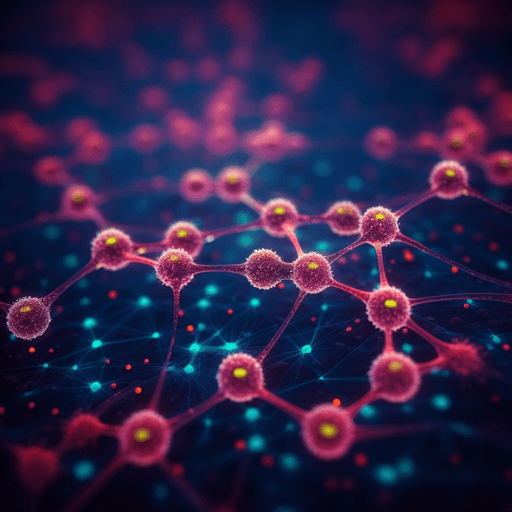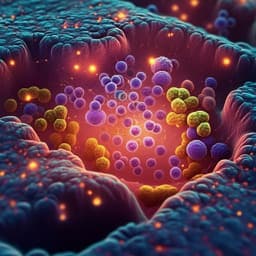
Biology
Connectome-seq: High-throughput Mapping of Neuronal Connectivity at Single-Synapse Resolution via Barcode Sequencing
D. Chen, A. Isakova, et al.
Connectome-seq is a high-throughput AAV-based method that maps neuronal connectivity at single-synapse resolution by combining engineered synaptic proteins, RNA barcoding, and parallel single-nucleus and single-synaptosome sequencing to capture both synaptic links and molecular identities. Research conducted by Danping Chen, Alina Isakova, Zhou Joe Wan, Mark J. Wagner, Yunming Wu, and Boxuan Simen Zhao.
~3 min • Beginner • English
Introduction
Mapping synaptic wiring diagrams (connectomes) at single-cell resolution is essential for understanding brain function. Complete invertebrate connectomes (C. elegans; adult Drosophila) have transformed circuit analysis but are not directly scalable to large mammalian brains. Serial-section electron microscopy (ssEM) has uncovered core organizational principles in vertebrate circuits (retina, entorhinal cortex, somatosensory and visual cortex, cerebellum) but is constrained to small tissue volumes and is laborious, limiting subject-level, long-range mapping. Mammalian circuits also show substantial individual variability, necessitating practical, scalable methods at single-cell resolution. Existing light microscopy and viral tracing approaches (e.g., mGRASP, SynView, genetic tracers) suffer from limited synapse resolution, viral tropism, toxicity, and a priori targeting biases. Sequencing-based methods (MAPseq, BARseq, BRICseq; barcoded rabies approaches) scale projection mapping but either lack postsynaptic identification (Sindbis-based) or suffer barcode mixing/toxicity (rabies-based). To overcome these constraints, the authors developed Connectome-seq: an AAV-based, minimally toxic, sequencing framework that converts individual synapses into pairs of RNA barcodes anchored by engineered synaptic proteins, and captures both nuclei and synaptosomes in parallel for single-synapse connectivity with molecular identities. The method is demonstrated in the mouse pontocerebellar circuit and reveals both canonical and potentially novel connections, with associated molecular markers.
Literature Review
- Foundational connectomics: complete C. elegans connectome and recent adult Drosophila brain reconstructions established large-scale wiring maps and their impact on hypothesis generation and modeling.
- Vertebrate ssEM studies revealed principles such as synapse sorting in entorhinal cortex, distance-dependent targeting and developmental emergence of inhibitory specificity in somatosensory cortex, structured inter-areal connectivity in visual cortex, and non-random motifs in the cerebellum. However, ssEM scales poorly for long-range, multi-region mapping.
- Non-single-cell mapping (e.g., DTI/fMRI) and low-throughput single-cell methods exist, alongside light-microscopy tools (mGRASP, SynView) and viral tracers; these face resolution, specificity, tropism, toxicity, and bias limitations.
- Sequencing-based neuroanatomy: MAPseq and BARseq map projections at scale (MAPseq lacks postsynaptic partners; BARseq preserves spatial context), BRICseq multiplexes tracing; barcoded rabies approaches (RABID-seq, SBARRO, newer scRNA-seq/in situ) demonstrate synaptic mapping but face barcode mixing and toxicity challenges.
- Prior attempt SYNseq proposed barcode joining across synapses but was limited by joining efficiency. Connectome-seq builds on these advances while aiming to mitigate toxicity and ambiguity using AAV and synaptosome/nuclei co-capture.
Methodology
Overview: Connectome-seq comprises (1) molecular engineering of synaptic protein–RNA complexes (SynBar) to encode each synapse as a pair of barcodes; (2) parallel isolation of nuclei and synaptosomes with FACS enrichment; and (3) modified 10x Genomics library construction for single-nucleus transcriptomes with barcodes and single-synaptosome barcodes, followed by computational error correction and barcode matching to reconstruct connectivity.
Molecular engineering (SynBar and barcodes):
- SynBar protein anchors: PreSynBar targets presynaptic terminals (modified neurexin 1β fused to split-GFP1–10 and λN22 RNA-binding domain) and PostSynBar targets postsynaptic sites (neuroligin 1 fused to GFP11 and λN22). Split-GFP fragments embedded within proteins to ensure reconstitution only upon correct trans-synaptic interaction. Extracellular epitope tags: V5 (PreSynBar) and HA (PostSynBar).
- Critical design: λN22 position is internal within PreSynBar’s C-terminal region; a C-terminally appended λN22 impaired trans-interaction. PostSynBar tolerates λN22 at extreme C-terminus.
- RNA barcodes: PreRNA and PostRNA include PCR handles, a 30-nt random region (N30) for high diversity, two BoxB sites for λN22 binding, and distinct 10x capture sequences (CS1 for PreRNA; CS2 for PostRNA). Transcribed by Pol II (polyA+) for enhanced nuclear export and synaptic abundance versus Pol III. PreRNA optimized for distal transport by adding 5′ UTR of RPL7 (best among tested UTRs).
- Stability: RNA immunoprecipitation showed >500-fold enrichment with SynBar λN22–BoxB interaction versus controls.
- In vitro validation: cis (same-cell) and trans (co-culture) assays in HEK293 and neurons demonstrated specific split-GFP reconstitution at cell–cell contacts.
AAV constructs and in vivo expression:
- Presynaptic mix: hSyn-Cre + hSyn-PreSynBar and hSyn-PreRNA (two-cassette design improves PreSynBar targeting and axonal localization) delivered bilaterally to pons. Postsynaptic mix: hSyn-Cre + Cre-dependent (DIO) PostSynBar and PostRNA to cerebellar cortex.
- Transgenic reporter: Sun1-Tag mice enable Cre-dependent nuclear membrane GFP for nuclei FACS enrichment.
- Stereotaxic injections (500 nL/site, 100 nL/min). Pons: +0.2 AP (λ), ±0.5 ML, −5.55 DV; Cerebellum (right vermis lobule V): +0.2 mm anterior to post-lambda midline, −3.0 ML, −0.5 DV. Expression 2–3 weeks.
Parallel isolation and FACS enrichment:
- Tissue homogenization in sucrose (SET) produces P1 (nuclei) and S1 (supernatant); S1 fast spin yields P2 synaptosomes.
- Nuclei FACS: SiR-DNA staining (far-red) resolves DNA content independently from GFP; sequential gating for singlets by DNA content then GFP+ infected nuclei; sort directly into collection buffer for immediate 10x loading.
- Synaptosome FACS: Sequential gating—events above noise (dual side scatter), singlets by scatter properties, membrane-intact via CellBrite 405 (top ~90% intensity), then V5+HA+ double-positives using WT-calibrated false-positive thresholds (<0.5% V5, <1% HA). PBS-based staining buffer improved antibody efficiency over sucrose buffer. Yield ~20,000 V5+HA+ synaptosomes/hour. Split-GFP native fluorescence was insufficient for cytometry; direct immunostaining against reconstituted GFP worked but was batch-variable; epitope-tag immunostaining adopted. Alternative axon/dendrite fluorescent tags produced ambient barcode contamination and were not used for barcoding.
Single-nucleus and single-synaptosome 10x library construction:
- Gel beads modified to include three capture oligos per bead: poly(dT) for mRNA; CS1 for PreRNA; CS2 for PostRNA.
- Nuclei libraries: initial co-amplification (PreAmp1), bead-based size selection to separate barcode (<300 bp) from mRNA (>300 bp) cDNA; separate amplification with barcode-specific primers; final indexing. qPCR verified expected PreRNA/PostRNA enrichment per region; ~99% of nuclei contained expected barcode.
- Synaptosome libraries: omit template-switch oligo; barcode-specific short-amp conditions favor short barcodes; split Pre/Post into separate PCR#2 reactions; bead cleanups optimized for small fragments; LNA-modified primers balanced Pre/Post amplification when abundances differed. qPCR validated specificity and minimal cross-contamination.
- Typical throughput: 20–30k nuclei per region; 30–140k double-positive synaptosomes per experiment.
Application to mouse pontocerebellar circuit (n=6 biological replicates):
- Robust PreSynBar expression in pontine neurons/axons and PostSynBar across cerebellar neurons; split-GFP signals at synapses. BaseScope in situ showed PreRNA/PostRNA colocalized with SynBar at mossy fiber terminals; PreRNA clustered in presynaptic glomeruli; PostRNA more dispersed with partial synaptic enrichment.
- snRNA-seq recovery: Pons total 180,468 nuclei (median 1,852 UMIs), cerebellum 129,192 (median 1,346 UMIs). Post-QC: pons 109,269; cerebellum 78,358. Pons composition: ~77% neurons, chiefly glutamatergic (Fat2 Glut, Hoxb5 Glut), GABAergic (Gata3 Gly-Gaba, Otp Pax3 Gaba, Onecut1 Gaba), and serotonergic (Tph2 Glut-Sero); non-neuronal ODCs, astrocytes, OPCs, endothelial cells, microglia, macrophages. Cerebellum: ~91% neurons: granule (~63% post-QC), MLIs (MLI1/2), Purkinje, PLI, Golgi, UBCs; plus Bergmann glia, ODCs, astrocytes, ependyma, choroid, endothelial, microglia, macrophages. Granule cell underrepresentation is a known single-nucleus technical bias (small soma/low RNA).
- Barcode co-detection in nuclei: pons 98.6% PreRNA+; cerebellum 98.7% PostRNA+.
Synaptosome barcode data characteristics:
- Among barcode-containing synaptosomes (~605k): 23.6% both Pre+Post (142,728); 17.9% Pre-only (108,377); 58.5% Post-only (354,196). Lower Pre capture likely reflects long-distance transport/dropout and CS1 vs CS2 capture efficiency.
- N30 diversity scaled with total UMIs; reads/UMI largely 1–10; Pre/Post abundances per synaptosome often asymmetric.
Computational pipeline and matching:
- Cell Ranger processing with custom references; barcode extraction from BAM; CB-UMI-based filtering; within-sample collapse at Hamming distance 1; network-based 30-mer correction; inter-sample matching allowing up to HD=2 (chosen to balance coverage/accuracy).
- Synaptosome unique barcodes: 81,452 Pre; 147,164 Post. Unique nuclear matches at HD=2: Pre 23,587 (29.0%) matched to presynaptic nuclei; Post 28,057 (19.1%) matched to postsynaptic nuclei.
- Filters: removed ambiguous nuclear barcodes (dominance ratio), synaptosomes with >100 unique barcodes, shared 10x CB between nucleus and synaptosome, barcodes associated with >100 synapses (ambient RNA control), retained highest-count nucleus–synapse pairs when multiple matches.
Validation and tracing for novel connectivity:
- Purkinje subclustering (7 subtypes): Connectome-seq positive Purkinje cells enriched in specific clusters (notably clusters 6 and 2). Marker genes enriched in connected Purkinje cells: Grid2ip (Delphilin), Cacna1g, Dagla, Stac, Zfp385c, Foxp4, Dlgap4, Mir9-3hg, Abr, Ryr1.
- Anterograde AAV1 tracing: AAV1-Cre into pons of Sun1-Tag mice labeled postsynaptic targets including Purkinje cells; scAAV1-DIO-oScarlet into pons of Pcp2-Cre mice robustly labeled Purkinje cells, supporting adult pons→Purkinje connections. Spatial gradient: higher lateral hemispheric and posterior vermis (VI–VIII) connectivity; minimal anterior vermis.
- Protein validation: immunostaining for Grid2ip/Delphilin, Cacna1g, Stac, Dlgap4, Abr confirmed expression in oScarlet+ Purkinje cells; Grid2ip showed a similar lateral-to-medial gradient; Allen Brain Atlas in situ corroborated Grid2ip expression in a Purkinje subset.
Ethics, reagents, and data:
- Animal use approved by Stanford and UIUC IACUCs; data deposited (GSE285978); code available on GitHub.
Key Findings
- High-efficiency barcode capture in nuclei: 98.6% of pons nuclei contained PreRNA; 98.7% of cerebellar nuclei contained PostRNA.
- Synaptosome barcode detection: Among ~605k barcode+ synaptosomes, 23.6% (142,728) contained both PreRNA and PostRNA; 17.9% (108,377) Pre-only; 58.5% (354,196) Post-only.
- Barcode diversity and matching: detected 81,452 unique PreRNA and 147,164 unique PostRNA barcodes in synaptosomes; unique nuclear matches at Hamming distance 2 were 23,587 Pre (29.0%) and 28,057 Post (19.1%).
- Matched nuclei: 3,539 pons nuclei and 1,951 cerebellar nuclei matched to synaptosomes. Estimated false discovery rate on pons side 9.7% when excluding GABAergic neurons; 11.8% when considering only glutamatergic neurons as true positives (excluding GABAergic and serotonergic).
- Cell-type match distributions and rates (examples): pons matched neurons predominantly glutamatergic (Fat2 Glut 1,992 cells, 56.3% of matched; 5.50% match rate; Hoxb5 Glut 1,130, 31.9%; 3.03%). Cerebellum matched: Granule 639 (32.8%; 1.29%), Purkinje 593 (30.4%; 6.47%), MLI1 334 (17.1%; 4.65%), Golgi 183 (9.4%; 12.9%), PLI 119 (6.1%; 5.71%), MLI2 76 (3.9%; 4.72%), UBC 7 (0.4%; 2.35%).
- Single-cell connectivity matrix: 280 pons neurons connected to 159 cerebellar neurons; ~27% of neuron pairs supported by >100 synaptosome barcode reads. Total unique matched synaptosomes across types ~343; pons sources: Fat2 Glut (194), Hoxb5 Glut (92), Gata3 Gly-GABA (33), Tph2 Glut-Sero (14), Otp Pax3 Gaba (9), Onecut1 Gaba (1). Cerebellar targets: Golgi (91), Purkinje (82), Granule (62), PLI (53), MLI1 (43), MLI2 (12–13).
- Discovery of adult pons→Purkinje connectivity: Connectome-seq and AAV1 anterograde tracing both indicate direct adult pons-to-Purkinje connections with a pronounced lateral-to-medial gradient (enriched in lateral hemispheres/posterior vermis). Molecular markers enriched in connected Purkinje cells include Grid2ip/Delphilin, Cacna1g, Dagla, Stac, Zfp385c, Foxp4, Dlgap4, Mir9-3hg, Abr, Ryr1; protein-level validations confirmed marker expression in traced Purkinje cells.
- Sensitivity estimates: Given sampling fractions and known synapse numbers, detection sensitivities differed markedly by connection type (e.g., MF→GrC ~0.0001% vs MF→Golgi ~0.216%), indicating cell-type and architecture-dependent detection performance.
- Technical performance: Dual-RNA capture in synaptosomes 23.6%; final validated connections account for ~8% of initial single-side-matched nuclei, pointing to optimization headroom in barcode design, isolation, library construction, and matching.
Discussion
Connectome-seq addresses the need for scalable, single-synapse–resolution mapping of long-range mammalian circuits while jointly capturing molecular identity. By anchoring paired RNA barcodes with engineered synaptic proteins and profiling both nuclei and synaptosomes, the method reconstructs connections between identified neurons without a priori genetic targeting constraints. In the pontocerebellar system, it recapitulates known mossy fiber connectivity to granule and Golgi cells and suggests additional targets (e.g., PLI), while revealing unexpected adult pons→Purkinje connectivity. The latter is supported by independent AAV1 anterograde tracing and enriched molecular markers (notably Grid2ip/Delphilin), and shows a lateral-to-medial gradient aligning with established pontine input patterns. This raises new questions about the organization and function of pontine inputs to Purkinje cells and highlights specific Purkinje subtypes preferentially engaged.
Compared to ssEM and light microscopy approaches, Connectome-seq improves throughput and long-range coverage, and compared to Sindbis- or rabies-based barcoding, it reduces toxicity and barcode mixing by using AAV and synaptosome-level pairing. Nonetheless, technical artifacts (ambient RNA, PCR errors, dropout) and sampling biases currently limit sensitivity and specificity. The estimated FDR (~10–12%) and sparse detection for certain synapse types underscore the need for further optimization. Integration with spatial transcriptomics and electrophysiology will be important to confirm novel connections functionally and to relate connectivity with physiological properties. As protocols for synaptosome preservation, barcode capture, and computational filtering improve, Connectome-seq should enable robust, comparative connectomics across brain regions, developmental stages, and disease states.
Conclusion
This work introduces Connectome-seq, a scalable AAV-based sequencing method that maps neuronal connectivity at single-synapse resolution while retaining single-cell transcriptomic identities. In the mouse pontocerebellar circuit, Connectome-seq captures thousands of connections, validates canonical pathways, and uncovers evidence for adult pons-to-Purkinje connectivity with distinctive molecular correlates (e.g., Grid2ip/Delphilin) and spatial gradients. The approach fills a critical gap between high-resolution but low-throughput EM-based reconstructions and large-scale but less specific tracing techniques. Future work should: (1) enhance synaptosome isolation and RNA preservation to improve dual-barcode capture; (2) refine barcode designs and library chemistries (e.g., LNA primers, capture sequences) to raise matching rates and reduce ambient RNA effects; (3) develop stricter computational deconvolution and error-correction to lower FDR; (4) optimize viral delivery per cell type to mitigate transduction biases; and (5) integrate electrophysiological and spatial modalities to confirm function and contextualize connectivity. These developments will further enable comprehensive, comparative mapping of long-range circuits in health and disease.
Limitations
- Technical: Dropout and low read depth per synaptosome; ambient RNA contamination can produce spurious matches; PCR/sequencing errors necessitate mismatch-tolerant matching, which increases false positives; dominance of mitochondrial RNA in synaptosomes precluded reliable mRNA capture, requiring barcode-only synaptosome libraries; barcode detection asymmetry (CS2>CS1) and PreRNA long-distance transport reduce dual capture.
- Sampling and bias: FACS selection and isolation can bias toward certain sizes/morphologies; AAV transduction efficiency differs by cell type; small, low-RNA nuclei (e.g., granule cells) are underrepresented after QC; only ~23.6% synaptosomes had dual barcodes; overall sensitivity for some connection types is very low (e.g., MF→GrC).
- Specificity: Estimated FDR ~9.7–11.8% on pons side; GABAergic pons matches likely reflect misassignment/ambient RNA or algorithmic false positives.
- Biological validation: Suggested adult pons→Purkinje connections, though supported by AAV1 tracing and molecular markers, require electrophysiological confirmation to establish functional synapses and transmission.
- Generalizability: Current workflow validated in one long-range circuit; performance in other regions and species requires further testing.
Related Publications
Explore these studies to deepen your understanding of the subject.







